ds
Harvest Moon: Grand Bazaar
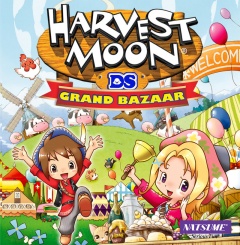 Like many, I was first introduced
to the concept of farming simulation via an obscure Facebook title called
Farmville. Not sure if that game flopped or not, but I didn't stick
around too long to find out as the idea of caring for crops day in,
day out did little to excite me. Sure, I like managing and being organized
and earning faux money, but in the end, there wasn't really much to
do with Farmville other than pester friends with countless requests
and click on the same things over and over. After some time passed,
I got the hankering again to water some crops and decided to give
Rune Factory: A Fantasy Harvest Moon a try; unfortunately, despite
being a farming simulator with bonus RPG dungeon-crawling elements,
I still wasn't entertained.
Like many, I was first introduced
to the concept of farming simulation via an obscure Facebook title called
Farmville. Not sure if that game flopped or not, but I didn't stick
around too long to find out as the idea of caring for crops day in,
day out did little to excite me. Sure, I like managing and being organized
and earning faux money, but in the end, there wasn't really much to
do with Farmville other than pester friends with countless requests
and click on the same things over and over. After some time passed,
I got the hankering again to water some crops and decided to give
Rune Factory: A Fantasy Harvest Moon a try; unfortunately, despite
being a farming simulator with bonus RPG dungeon-crawling elements,
I still wasn't entertained.
Scanning the shelves of my local GameStop recently, I noticed a bunch of other Harvest Moon games on the DS. Like, a ton. There were at least three sitting eye-level, staring me in the face, begging to be watered. And I got that itch again. I decided to give the most newest title a chance. Let's see if Harvest Moon: Grand Bazaar is different enough to grow into something fun, something edible.
Monster Tale
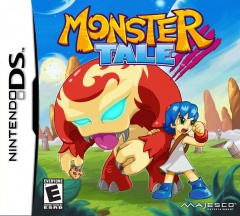 I love genre mashing, and Monster Tale is certainly a special case of mixed, but excellent heredity. We have the popular and super combination of Metroid and Castlevania, plus monster training that mixes Pokemon, Tamagotchi, and E.V.O.: Search for Eden. Excellent genes also bears the burden of high expectations, however, can Monster Tale possibly meet them?
I love genre mashing, and Monster Tale is certainly a special case of mixed, but excellent heredity. We have the popular and super combination of Metroid and Castlevania, plus monster training that mixes Pokemon, Tamagotchi, and E.V.O.: Search for Eden. Excellent genes also bears the burden of high expectations, however, can Monster Tale possibly meet them?
Released on the Nintendo DS late last month, Monster Tale was developed by DreamRift and published by Majesco. It pairs up a young girl and her monster that evolves and grows throughout the game. Trapped in a world ran by children who think themselves royalty, our young heroine is a bit like Dorothy in Oz, just with Chomp for companionship.
I originally meant to write at least a half-hour handheld review of Monster Tale, but I kept playing and before I knew it, the game was over. Here is my review of Monster Tale for the Nintendo DS.
999: Nine Hours, Nine Persons, Nine Doors
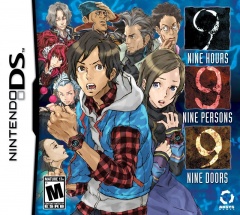 For the last few years, I’ve been attempting to answer the question “would I keep playing?” after finishing the first hour of a video game. It is kind of a loaded question, as I’m trying to answer for just myself, but also consider the millions of readers out there who might be wondering the same thing. I enjoy genres many people don’t, and I also have wildly varying opinions on a lot of games, so if I’m on the fence, I’ll generally give the game in question the thumbs up. In the end, the wording is important: I would keep playing if I had the time and energy to do so, but chances are I’m still chugging through Dragon Age: Origins.
For the last few years, I’ve been attempting to answer the question “would I keep playing?” after finishing the first hour of a video game. It is kind of a loaded question, as I’m trying to answer for just myself, but also consider the millions of readers out there who might be wondering the same thing. I enjoy genres many people don’t, and I also have wildly varying opinions on a lot of games, so if I’m on the fence, I’ll generally give the game in question the thumbs up. In the end, the wording is important: I would keep playing if I had the time and energy to do so, but chances are I’m still chugging through Dragon Age: Origins.
After a half-hour with the Nintendo DS game 999: Nine Hours, Nine Persons, Nine Doors, I was emphatically done (we sometimes give portable games just the 30 minute treatment with the assumption that being a portable game, they might get things rolling quicker). It was a bizarre experience, to say the least. But then its fans started to comment. Commenters arrive in many forms, sometimes they’re offended that I seemingly insulted their game as if it was their mother, but sometimes they come as defenders of justice. 999 fans appeared as the latter.
So I gave the game another shot, replayed the beginning and on from there. I beat 999 three times in total to achieve the true ending, and in the end, I enjoyed my experience. My final score for the game was hard to pin down, so pay more attention to the text than the number.
Radiant Historia or: How I learned to enjoy Japanese RPGs again
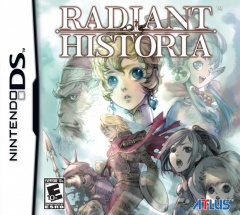 A year ago I vented how Persona 3 and Odin Sphere had destroyed my love for Japanese RPGs, one of my favorite video game genres growing up. I might have been a bit dramatic about the situation, but the two games left such bad tastes in my mouth I had to take a break from the genre. This lasted about six months before I ventured back into the land of turn-based rising sun with Sega’s Infinite Space, a game that has all the trappings of crappy JRPGs but turned out to be pretty great in the end.
A year ago I vented how Persona 3 and Odin Sphere had destroyed my love for Japanese RPGs, one of my favorite video game genres growing up. I might have been a bit dramatic about the situation, but the two games left such bad tastes in my mouth I had to take a break from the genre. This lasted about six months before I ventured back into the land of turn-based rising sun with Sega’s Infinite Space, a game that has all the trappings of crappy JRPGs but turned out to be pretty great in the end.
Since then I’ve beaten Golden Sun 3: Dark Dawn, Black Sigil: Blade of the Exiled, and Radiant Historia. It’s been a mixed bag and a reminder that I’m not back in love with the genre, but one game in particular pretty much brought me back into the fold: Atlus’ newest Nintendo DS title, Radiant Historia.
Released in February, Radiant Historia chewed up more portable gaming time than anything I’ve played in recent memory. The idea that a 50 hour game should be imposing to someone with limited gaming time like myself didn’t matter, I plowed through it and the game was worth every minute. Here’s my review of Radiant Historia.
Retiring my Nintendo DS Lite
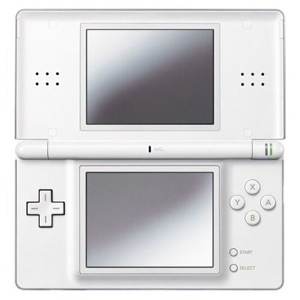 The Nintendo DS was the first game system that I followed from
announcement to launch. It was way back early 2004 that Nintendo first
hinted at a dual-screened handheld, then codenamed "Nitro." Considering
that was the only information available, it's not surprising that many
questioned Nintendo's strategy. Why two screens? Nintendo offered some
hypothetical benefits, like extra camera angles for sports games, but
their words were hardly convincing. Little did we know, it was
Nintendo's first step into the "blue ocean" strategy that would lead the
company to greener pastures.
The Nintendo DS was the first game system that I followed from
announcement to launch. It was way back early 2004 that Nintendo first
hinted at a dual-screened handheld, then codenamed "Nitro." Considering
that was the only information available, it's not surprising that many
questioned Nintendo's strategy. Why two screens? Nintendo offered some
hypothetical benefits, like extra camera angles for sports games, but
their words were hardly convincing. Little did we know, it was
Nintendo's first step into the "blue ocean" strategy that would lead the
company to greener pastures.
And yet, the original DS launch in November 2004 came and went with little fanfare. I was aware of the date, but didn't even realized that it arrived until I walked through a Wal-Mart electronics section and saw the grey handheld on the shelves. I kept walking. I was Nintendo faithful, sure, but it was hard to get excited about a launch lineup headlined by something nearly a decade old. It wasn't until the impending release of Kirby Canvas Curse in the summer of 2005 that I decided to bite the bullet, trading in half of my Gamecube library to GameStop in order to pay off the Nintendo DS and one game.
While it's certainly worth praise in its own right, I think Canvas Curse deserves to be remembered as the flagship of the DS library; it was the first of a fleet of incredible games that would follow in its wake. A system redesign, dubbed the DS Lite, accompanied the platform's newfound software vigor. Reduced size, brighter screens, and an iPod aesthetic provided enough worth for many to upgrade (including me) and many more to buy in for the first time. The sleeker profile and beefier games are what truly began the success story of the best-selling handheld game system ever.
But even Nintendo's first detour in the generations-old graphical arms race would lead to a dead end eventually. With the launch of a successor, the 3DS, history tells us that the best we can hope for is a year or two of life support for what was once Nintendo's "third pillar." It was an incredible performance that none could have predicted, and I think the Nintendo DS deserves a hearty round of applause before its curtain call. I've decided to contribute to the celebration in that age-old tradition of blogging: the top ten list.
In no particular order, here are ten great games that exemplified some aspect of the Nintendo DS' legacy.
Okamiden
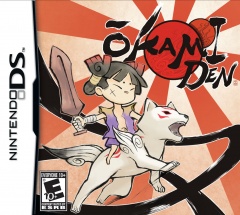 Before I say anything, I beat Okami. It was a fun game with some issues, and my PlayStation 2 version is an important part of my video game collection.
Before I say anything, I beat Okami. It was a fun game with some issues, and my PlayStation 2 version is an important part of my video game collection.
Before I say anything else, I didn’t like the first hour of Okami. It’s one of the few games I went back to play the first hour of because I thought it would illustrate well what a bad first hour looked like, and I was right. But it’s also a good example of where this site can go wrong. Some games like Okami just take a long time to get going, but this can also cause gamers to quit prematurely, like my friend and fellow writer Steve did.
Enter Okamiden, the chibi-ized version of Okami for the Nintendo DS. Okamiden will likely go down as one of the last good DS games before the 3DS is released in a few weeks (hopefully time remembers Radiant Historia, as well). Because I enjoyed Okami but didn’t like its first hour, Okamiden seems like the perfect game to try out for a bit. Will Capcom repeat the same mistakes they made with Okami? Will the game be too targeted for children? How will the gameplay and stylized graphics translate to the small screen?
Released yesterday, here is Okamiden’s first hour.
Black Sigil: Blade of the Exiled
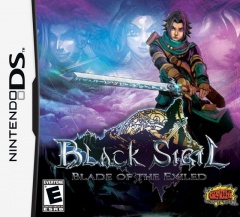 During the Super Nintendo era, Squaresoft was peaking with Secret of Mana, Final Fantasy VI, and Chrono Trigger. The developer defined the Japanese RPG genre with those titles and also completely owned the marketplace for years to come. It’s easily arguable that Square has since lost the JRPG title to other developers such as Atlus (with its recent bit of awesomeness titled Radiant Historia in particular), but they’ll never have their triumphant 16-bit period taken away from them.
During the Super Nintendo era, Squaresoft was peaking with Secret of Mana, Final Fantasy VI, and Chrono Trigger. The developer defined the Japanese RPG genre with those titles and also completely owned the marketplace for years to come. It’s easily arguable that Square has since lost the JRPG title to other developers such as Atlus (with its recent bit of awesomeness titled Radiant Historia in particular), but they’ll never have their triumphant 16-bit period taken away from them.
Black Sigil: Blade of the Exiled is a love letter to that era. With sprites and animations seemingly ripped straight out of Chrono Trigger and Final Fantasy VI, and a story that sounds by-the-formula familiar to fans of the genre, this 2009 Nintendo DS release appears to be just another Japanese RPG title. But surprisingly, Black Sigil was developed in Montreal, so yes, this is one of those rare Canadian Japanese RPGs.
Developed by Studio Archcraft and published by Graffiti Entertainment, Black Sigil is also a bit of an indie title. The credits listed the same eight names over and over while the title was so long in development that it was originally targeted for the Game Boy Advance.
Unfortunately, the team had their goals so loftily set that I believe they lost sight of what made Squaresoft’s games so great: they were fun. Black Sigil is plagued by some major issues that most people will find the game unplayable beyond a few hours. I stuck it out though, and here’s my review.
Radiant Historia
 Radiant Historia hasn’t been on my radar for very long, but ever since I learned about it a month ago, I have been very excited to play it. As a Japanese RPG from Atlus, the game already has the pedigree, but the story is what really grabbed me. Radiant Historia is a time traveling game where your goal is to correct the timeline and save your homeland. Yes, this sounds a bit like Chrono Trigger, and you wouldn’t be totally wrong comparing them, but Radiant Historia has its own unique twists to offer up.
Radiant Historia hasn’t been on my radar for very long, but ever since I learned about it a month ago, I have been very excited to play it. As a Japanese RPG from Atlus, the game already has the pedigree, but the story is what really grabbed me. Radiant Historia is a time traveling game where your goal is to correct the timeline and save your homeland. Yes, this sounds a bit like Chrono Trigger, and you wouldn’t be totally wrong comparing them, but Radiant Historia has its own unique twists to offer up.
The game’s timeline is presented like you’re navigating a large skill tree, with decisions made creating forks in the fabric of time. You can revisit these forks and make different decisions, and even learn skills and information in a dead-end timeline to return to the correct route and proceed. This sounded just like the game I’ve been wanting to play for a long time.
Released yesterday, Radiant Historia has been getting some great early reviews. I was able to get my hands on it to present my impressions as quick as possible. Here’s the first hour of Radiant Historia.
Ghost Trick: Phantom Detective
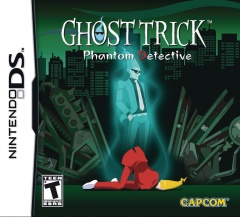 I've been anticipating Ghost Trick: Phantom Detective for a while now. As a big fan (but totally burned out) of the Ace Attorney series, I was excited for Phoenix Wright's creator's next vision. It's an odd one, that's for sure, but holds on to the humor, great cast of characters, and overwhelming charm that made the Ace Attorney series so great.
I've been anticipating Ghost Trick: Phantom Detective for a while now. As a big fan (but totally burned out) of the Ace Attorney series, I was excited for Phoenix Wright's creator's next vision. It's an odd one, that's for sure, but holds on to the humor, great cast of characters, and overwhelming charm that made the Ace Attorney series so great.
In Ghost Trick, you unsurprisingly play as a ghost. The idea is you can manipulate objects from the ghostly dimension to save people's lives and ultimately, find out who you are and why you were killed. The Phoenix Wright-like mystery is present throughout the game and many of the questions aren't answered until the last action is taken, but it's a fun and original ride all the way there.
Phantom Detective shouldn't be a game that can be explained easily, but its first half-hour managed to do a pretty bang-up job. Check that out for an early walkthrough of all the concepts and in-depth gameplay elements the game explains to you quickly and efficiently.
Golden Sun: Dark Dawn
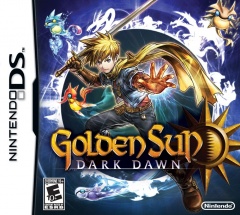 The Nintendo DS is easily the go-to console this generation when it comes to RPGs. As a developer, you'd be hard-pressed to have your title stand out in a library already rife with role-playing goodness. There are exceptions however, and Camelot's Golden Sun franchise is certainly one of them. The series' notoriety on the Game Boy Advance was enough to perk people's ears when Golden Sun: Dark Dawn was first announced. The sequel comes to us 7 years after the The Lost Age, with 30 years having passed in the game's universe. The original GBA games were hits. Does the sequel live up to the legacy they left behind?
The Nintendo DS is easily the go-to console this generation when it comes to RPGs. As a developer, you'd be hard-pressed to have your title stand out in a library already rife with role-playing goodness. There are exceptions however, and Camelot's Golden Sun franchise is certainly one of them. The series' notoriety on the Game Boy Advance was enough to perk people's ears when Golden Sun: Dark Dawn was first announced. The sequel comes to us 7 years after the The Lost Age, with 30 years having passed in the game's universe. The original GBA games were hits. Does the sequel live up to the legacy they left behind?
If you take a glance at the beginning of my First Hour review, you'll see that I've listed what, I feel, makes a damn good Golden Sun game. I thought I'd keep this review simple and basically go through each of the points I already made and comment on what's changed and whats been added or subtracted from the core experience.
